Top Tips to Identify Your Ideal Target Audience
You can’t afford to target everyone, and even if you could, it would be a bad idea.
After investing time, energy, and money in your business, it’s only natural that you want to shout about its products or services from the rooftops. I get it, but you have to face the reality that telling anyone and everyone about your offerings isn’t a strategy. In fact, it’s a sure-fire way to blow a lot of money in a short space of time and see very little in return.
Finding the ideal target audience is the key to optimising your conversions, making the most of your marketing strategy and your budget.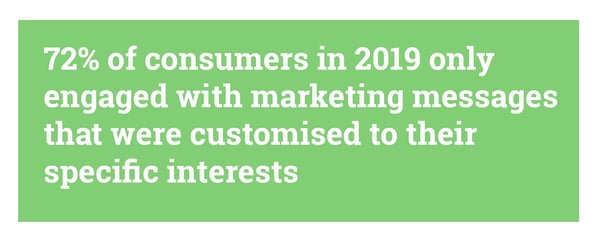
Source: Smarter HQ
What is a Target Audience?
The definition of a target audience is a group of consumers or organisations who are most likely to purchase your products or services.
The most common data points that are used to define the target audience of a company are:
It’s important to note here that the term ‘target audience’ is often used interchangeably with another marketing term, ‘target market’. There are, however, subtle differences between the two that you must be aware of.
The target market for a product is the people most likely to use the product, whereas the target audience for a product is the people most likely to purchase that product.
For example, the target market for a children’s bookshop is 2 - 11-year-olds, and the target audience for the same bookshop is parents, grandparents, aunts and uncles, etc.
Marketers use demographic data, such as age, gender, income, etc., and psychographic data, such as likes, dislikes, opinions, values, etc., to define their target audience.
Why identify a target audience?
- Build Stronger Connections
Modern consumers are connection-driven; they want brands to appeal to them as people with lives, dreams, and emotions of their own. By identifying your ideal target audience, you’re embarking on a research project to find out what appeals to these people. The more you find out about your target audience, the stronger connection you can build with consumers. - Enable Market Segmentation
When you identify your target audience, you are thinking about a segment of the total market. Although based upon data and research, this audience is still quite generalised. There is the potential to further segment consumers based on shared characteristics and interests within the target audience. Market segmentation allows you to tailor your messaging to each audience segment, personalising your customer’s experience even more. - Optimise Budgets Efficiently
The U.S. Small Business Administration suggests that 7% to 8% of your gross revenue should be spent on marketing. That’s not a lot when you consider that brands today are expected to deliver end-to-end omni-channel marketing experiences. Targeting your spending towards hyper-specific areas of the market increases your chances of conversion by efficiently spending your money where it matters most.
5 Top Tips to Identify Your Ideal Target Audience
-
Understand your company’s offerings
Before you begin looking outward towards customers to fit your target audience, you need to reflect inward on your company’s offerings, products, and values. The only way to identify the right target audience for your business is to know your offerings inside-and-out.
Sales experts point to the critical difference between product knowledge and product understanding; the former is about knowing the basic facts and figures, whereas the latter is how those facts affect the product owner. It is this understanding that will increase your ability to convey value to a consumer.
There are many levels to product understanding, and only when you have covered each factor in detail will you be able to determine the target audience that is right for your product or service.
- The FAB matrix
The FAB (Feature, Advantage, Benefit) matrix helps map the functionality of your product to the benefits it provides to the user.
Often, in the process of marketing a product, the definition of features, advantages, and benefits can become confused.
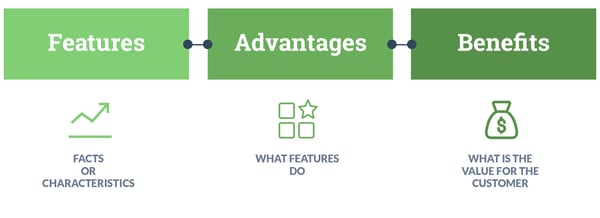
Source: TrainingINDUSTRY
Features are something your product has or is; for example, a hybrid mountain bike has a lightweight and aerodynamic frame.
Advantages are things that these features do; for example, lightweight frames on hybrid mountain bikes enable users to travel at higher speeds when traversing flat ground.
Benefits are the outcomes or results that users will experience if they use the product correctly; for example, a hybrid mountain bike user will be required to expend less energy when navigating the city terrain on their daily commute.
As a marketer, we get close to our products; so close, we can forget that customers don’t automatically see the benefits of our products when faced with the facts and figures of features.
The FAB matrix helps you to continually answer one fundamental question for your prospects: “What’s in it for me?” Knowing your benefits inside out will help you to identify the target audience whose pain points you can solve.Here’s a free template to get you started with your FAB analysis.
-
Unique Selling Point (USP)
Now that you have identified all of the benefits that your products or services offered to your customers, you can determine the unique selling point. Your company USP is the factor or benefit that makes your product stand out from its competitors.
For example, the auto insurance company, Geico’s, USP is perfectly encapsulated in their slogan: “15 minutes could save you 15% on car insurance.” Geico customers benefit from faster service and discounted rates.
Identifying your USP will take a deep understanding of the market you’re operating within and the offerings of your competitors. Comparing and contrasting your products and customer experience with your rivals will help you identify where you come out on top and, in turn, help you identify a target audience who would benefit most from your USP. -
Core brand values
How you treat your customers, employees, and the world around you is crucial; your company ethics can impact your business reputation, help you retain talented employees, and limit risk.
According to research conducted by Accenture, 63% of global consumers they spoke to prefer to purchase from brands that stand for a purpose that reflects their values and beliefs. Picking any old soap-box and standing on it isn’t going to cut it, however, as 62% have also been recorded as saying the authenticity of a brand’s ethics and values is important to them. Customers can see through any half-baked attempt to bandwagon on a popular cause (see: greenwashing or rainbow-washing).
Evaluate what your company stands for, and make a real effort to contribute to the conversation and practise what you preach. One brand who has nailed their core values, and therefore their target audience, is the clothing company, Lucy & Yak.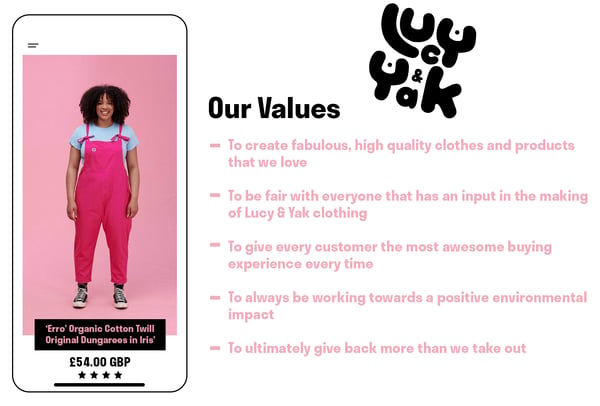
- The FAB matrix
2. Identify your current customers
Behavioural data is your best friend when it comes to identifying your target audience - especially if you’ve been operating a mass marketing strategy for some time but have finally seen the light!
You can reach into various owned data sources and pull out fascinating information about the types of people who are already purchasing your products or engaging with your marketing content.
a. Customer Relationship Management (CRM) System
A CRM system is a software used to manage companies’ interactions with current or potential customers. These systems store data based on customer information, such as name, age, email, phone number, address, job title, company, etc., and behaviour like previous purchases, items viewed, emails opened, and much more.
Many CRM systems have built-in analytics that can tell you a lot about your current customers and your ideal target audience. Looking specifically at the cohort of contacts within your CRM that have completed a purchase, you should be able to identify patterns such as location clusters or lifecycle stage.
CRM systems also hold data on your website performance which can give you an insight into the types of content your customer base enjoys. Use your analytics to record the most popular types of content and the content doesn’t perform as well and use this data to create content optimised to suit your customers’ interests.
b. Social Media Insights
Social media may seem like one of your businesses great burdens, yet another job piled onto your already hefty workload. However, if managed correctly, social media can be one of the most effective tools you can use to reach and engage with your target audience, and find out a lot about them too.
Analytics are built into the core of any business social media account; these insights are free and just waiting to be discovered. Each platform displays follower information differently, so be sure to analyse each data source separately and with purpose.
Facebook insights can be a great source of information when it comes to identifying your target audience based upon your existing followers. You can discover demographic data, like age range and gender, and geographic data from your Facebook business page. Or by logging into Facebook ads manager, you can gain even more insights such as education, income, relationship status, interests and activities, etc.
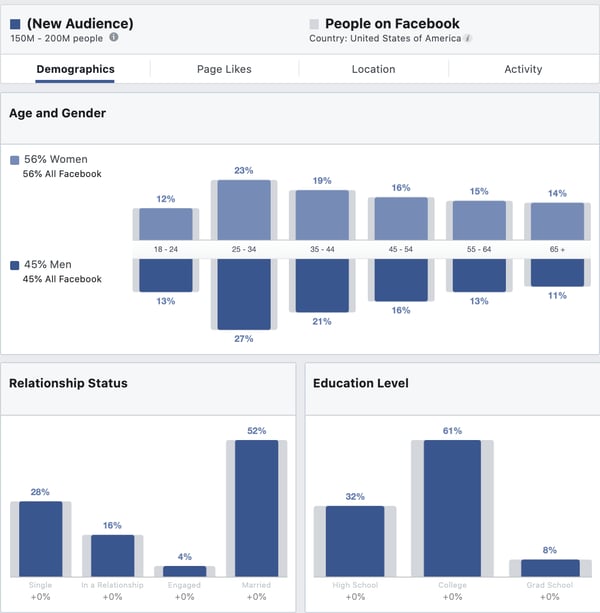
c. Google Analytics
If you find data fascinating, you may lose hours of your life scrolling through Google Analytics looking at its different reports. It really is an ocean of information and a great way to identify the types of consumers already interacting with your brand.
Using the Google Analytics Audience tab, you can quickly see who your customers and website visitors are, their interests, and their locations. Google’s psychographic data is broken down into two main categories:
-
- 1. Affinity markets:
- Google analyses interests, lifestyles, and habits, filtering users into categories like Technophile, TV Lover, Film Buff, Pet Lover, Political Junkie, etc.
2. In-Market segments:- Users in this category are lower in the funnel and are more likely to be actively interested in making a purchase or comparing your product with others.
d. Customer Surveys - Last but not least, if you want to find out something, is there any better option than going straight to the source? By this, I mean directly asking your current customers about themselves via customer surveys.
- Customer surveys allow you to identify and define the needs of your target audience, gather opinions on previous marketing campaigns, find out which channels your target audience uses most often, and highlight any weaknesses for your business.
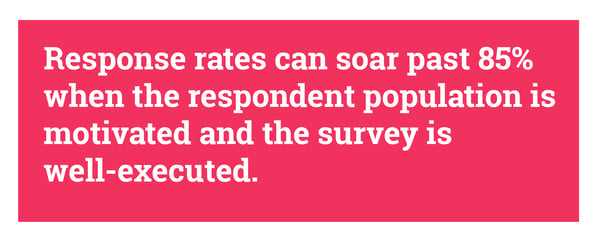 Source: SurveyGizmo
Source: SurveyGizmo - If you’re struggling with which pain points your product is solving for your current customers, surveys are a great place to find out and easily group common answers. Try asking questions like:
- What is your gender, age, location?
- What are your interests and hobbies?
- Do you use social media? If so, which channels?
- Where did you discover our brand?
- What made you decide to purchase ‘product x’?
- What problem did ‘product x’ solve for you?
- What would you like to know more about ‘product x’ and how to use it?
- What types of content would help you use your product? (blogs, videos, guides, etc.?)
- Would you recommend ‘product x’ to a friend?
- How would you improve ‘product x’?
- There are a number of different platforms that you can use to carry out surveys; from more traditional methods like over the telephone to emailing a survey hosted by Google forms or Survey Monkey, or even using Instagram stories to collect responses. CoSchedule have 3 golden rules to always follow when it comes to customer surveys:
-
- Know what you want to learn from each question
- Make questions short and easy to answer
- Consider offering a giveaway or reward for taking a survey
3. Conduct competitor analysis
Taking a look at your direct competitors can tell you a lot about the target audience you should be focusing your attention on. It may be the case that your product or service is superior, or your USP is more convincing, in which case going after the same target market as them could lead to you convincing their current customers to switch to your brand.
Alternatively, looking at who your competitors are targeting can help you identify areas where they are not operating; untapped markets hold great potential if you can find them and speak to them with the correct messaging.
Conducting a competitor analysis is a great way to assess the strengths and weaknesses of your direct and indirect competitors. We have written extensively about the competitor analysis process, outlining the steps you should take and how to conduct an SEO competitor analysis to find out which keywords your competitors are gaining the most traffic from.

4. Make use of market research
By this point, you should have a rough idea of who your target audience is shaping up to be; from your current customers, your competitor’s target audience and your own brand’s offerings and values.
It’s likely that you are now able to answer the following questions:
- What age is my target audience?
- What gender are they?
- Where do they live?
- What is their income?
Now you need to drill down into this target audience to find out more about their demographics and psychographics. There are a number of methods you can use to conduct market research outside of your existing customer base:
a. Gather primary research: Conduct interviews
Interviewing people from within your prospective target audience is another useful way to gain insight into their needs, opinions and lifestyles. The interviews that you conduct can be qualitative or quantitative and can take place face-to-face, over the phone, or digitally via platforms like Zoom or Skype.
Obviously, it would be impossible to interview every single person that makes up your target audience, but it is important to ensure your sample is representative of that section of the target population. The larger the sample you interview, the more representative your data will be. If your sample isn’t representative, it will be subject to bias and this can impact your ability to reach your target audience with your marketing efforts.
For example, if you’re conducting interviews with college graduates between the ages of 25-30 but you only speak to white, middle-class males, your research will result in very biased data.
How do you achieve representative samples?
1. Probability or random sampling
Involves choosing respondents from your target population at random. This method is less common as it requires up-to-date details for the target population, which is not possible for many audiences.
2. Non-probability or purposive sampling
Interview conductors place controls and quotas on the types of respondents chosen to take the interviews and specific groups of people are selected to ensure the sample is correctly balanced.
b. Conduct secondary research: Research trends surrounding your chosen demographic(s)
Using data collected by organisations like the Pew Research Centre can give you a powerful insight into many of the trends affecting your target market and how your products can help.
For example, if your customer surveys and purchase histories show a pattern around mothers aged 29 - 35 in the US, you can easily search the PRC database and find tons of up-to-date research in this area.
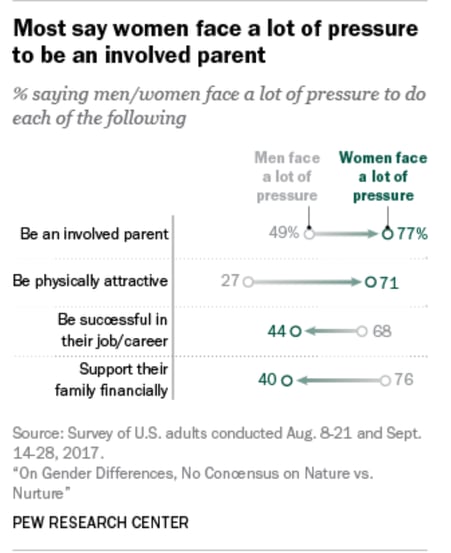
Source: Pew Research Centre
5. Create User Personas
A user persona, or a buyer persona as it’s also known, is a semi-fictional representation of your ideal customer based on all of the market research you have carried out and real data from your current customer base.
By creating user personas, you will gain a tangible focus that you can think back to when planning your marketing campaigns, content, and products in the future. Each time you take a new action in your business, however small, you should ask yourself: “how does this serve my user personas?” If it doesn’t, then you’re heading in the wrong direction.
Your user personas are a visualisation of the most common and valuable type of customers that you wish to attract with your marketing. For that reason, you want to think about them like a real person, right down to their name and what they might look like; humanising your buyer persona will help you relate to them better.
If, for example, let’s imagine I am creating a buyer persona for a homeware & furniture company. I have identified their target audience to be young couples and first-time buyers due to their on-trend designs and affordable prices, one of my buyer personas may look something like this:
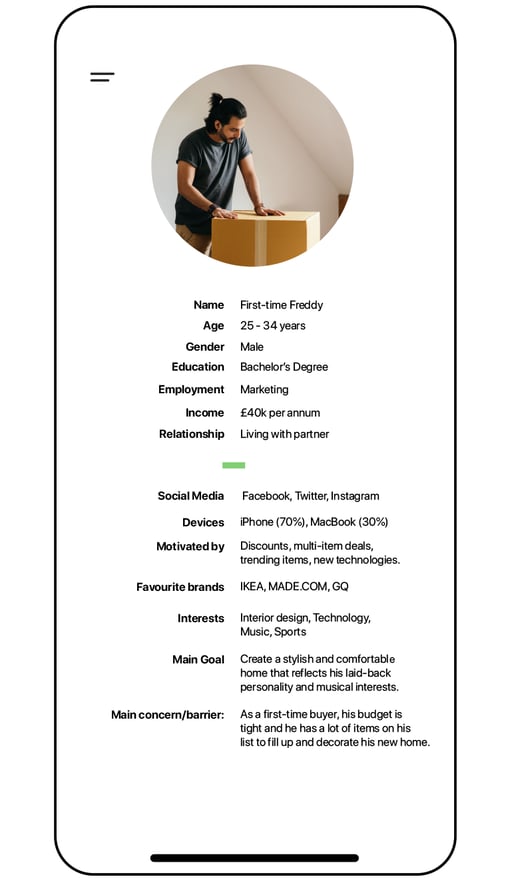
And there you have it! You now have all of the tools to identify and build your ideal target audience and create content that speaks directly to their needs.
Throughout this process, you may have been surprised to find out details about your target audience that you did not anticipate or that is contrary to your assumptions about them. It’s vital that you keep an open mind during this process and trust that your new target audience is based on research and fact, rather than return to your mass marketing habits. You will see rewards in time with higher conversion rates, increased customer engagement and retention.
Share this
You May Also Like
These Related Stories
.jpg)
10 Competitor Analysis Tools Every Marketer Needs

What Are The Major Components of a Marketing Strategy?
-3.png)

